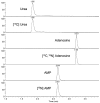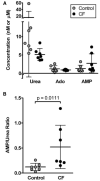A mass spectrometric method to simultaneously measure a biomarker and dilution marker in exhaled breath condensate
- PMID: 18257110
- PMCID: PMC2578813
- DOI: 10.1002/rcm.3408
A mass spectrometric method to simultaneously measure a biomarker and dilution marker in exhaled breath condensate
Abstract
Exhaled breath condensate (EBC) collection is a simple and non-invasive method to sample airway secretions, but analysis is limited by extensive and variable dilution of airway secretions within the condensate. To overcome this limitation, we developed a sensitive and specific liquid chromatography/tandem mass spectrometry (LC/MS/MS) method to simultaneously detect adenyl purines as biomarkers of inflammation and urea as a dilution marker in EBC. Separation prior to mass spectrometry was achieved using a C18 column with methanol and formic acid as the mobile phase, and characteristic precursor to product ion transitions of m/z 268 to 136 (for adenosine), m/z 348 to 136 (for AMP), and m/z 61 to 44 (for urea) were monitored for quantification. To correct for matrix effects, isotopically labeled adenosine, AMP, and urea were used as internal standards. Using these methods, we detected urea and the adenyl purines adenosine and AMP in EBC from seven subjects with cystic fibrosis (CF) and seven healthy controls and found that the AMP/urea ratio was elevated in the CF samples. These results demonstrate that mass spectrometry can be used successfully in EBC analysis to simultaneously detect a biomarker for airway inflammation and control for variable dilution.
Figures




Similar articles
-
Mass spectrometric analysis of biomarkers and dilution markers in exhaled breath condensate reveals elevated purines in asthma and cystic fibrosis.Am J Physiol Lung Cell Mol Physiol. 2009 Jun;296(6):L987-93. doi: 10.1152/ajplung.90512.2008. Epub 2009 Mar 20. Am J Physiol Lung Cell Mol Physiol. 2009. PMID: 19304910 Free PMC article. Clinical Trial.
-
Ion mobility and liquid chromatography/mass spectrometry strategies for exhaled breath condensate glucose quantitation in cystic fibrosis studies.Rapid Commun Mass Spectrom. 2013 Oct 30;27(20):2263-71. doi: 10.1002/rcm.6683. Rapid Commun Mass Spectrom. 2013. PMID: 24019192
-
Elevated airway purines in COPD.Chest. 2011 Oct;140(4):954-960. doi: 10.1378/chest.10-2471. Epub 2011 Mar 31. Chest. 2011. PMID: 21454402 Free PMC article.
-
LC/MS/MS analysis of leukotriene B4 and other eicosanoids in exhaled breath condensate for assessing lung inflammation.J Chromatogr B Analyt Technol Biomed Life Sci. 2009 May 1;877(13):1272-80. doi: 10.1016/j.jchromb.2009.01.036. Epub 2009 Feb 2. J Chromatogr B Analyt Technol Biomed Life Sci. 2009. PMID: 19233745 Review.
-
Exhaled breath condensate (EBC) in respiratory diseases: recent advances and future perspectives in the age of omic sciences.J Breath Res. 2024 Sep 23;18(4). doi: 10.1088/1752-7163/ad7a9a. J Breath Res. 2024. PMID: 39270682 Review.
Cited by
-
A feasibility study into adenosine triphosphate measurement in exhaled breath condensate: a potential bedside method to monitor alveolar deformation.Purinergic Signal. 2018 Sep;14(3):215-221. doi: 10.1007/s11302-018-9607-6. Epub 2018 May 12. Purinergic Signal. 2018. PMID: 29752619 Free PMC article.
-
Metabolomic biomarkers predictive of early structural lung disease in cystic fibrosis.Eur Respir J. 2016 Dec;48(6):1612-1621. doi: 10.1183/13993003.00524-2016. Epub 2016 Nov 11. Eur Respir J. 2016. PMID: 27836957 Free PMC article.
-
Comparison of Ambient and Atmospheric Pressure Ion Sources for Cystic Fibrosis Exhaled Breath Condensate Ion Mobility-Mass Spectrometry Metabolomics.J Am Soc Mass Spectrom. 2017 Aug;28(8):1489-1496. doi: 10.1007/s13361-017-1660-9. Epub 2017 Mar 31. J Am Soc Mass Spectrom. 2017. PMID: 28364225
-
Metabolomic Evaluation of Neutrophilic Airway Inflammation in Cystic Fibrosis.Chest. 2015 Aug;148(2):507-515. doi: 10.1378/chest.14-1800. Chest. 2015. PMID: 25611918 Free PMC article.
-
The Differences in the Levels of Oxidative Status Marker and Soluble CD95 in Patients with Moderate to Severe COPD during an Exacerbation and a Stable Period.Oxid Med Cell Longev. 2021 Dec 9;2021:2105406. doi: 10.1155/2021/2105406. eCollection 2021. Oxid Med Cell Longev. 2021. PMID: 34925689 Free PMC article.
References
-
- Larsen GL, Holt PG. Am J Respir Crit Care Med. 2000;162:S2. - PubMed
-
- Boucher RC. Eur Respir J. 2004;23:146. - PubMed
-
- Effros RM, Dunning MB, 3rd, Biller J, Shaker R. Am J Physiol Lung Cell Mol Physiol. 2004;287:L1073. - PubMed
-
- Effros RM, Biller J, Foss B, Hoagland K, Dunning MB, Castillo D, Bosbous M, Sun F, Shaker R. Am J Respir Crit Care Med. 2003;168:1500. - PubMed
-
- Rahman I, Biswas SK. Redox Rep. 2004;9:125. - PubMed
Publication types
MeSH terms
Substances
Grants and funding
LinkOut - more resources
Full Text Sources
